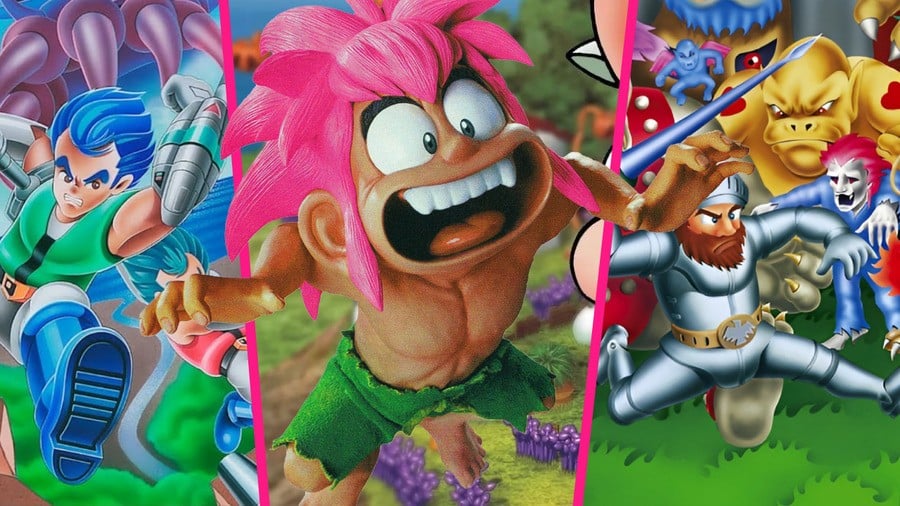
When it comes to the art of video game composing, we’d wager there are few people alive who have as enviable a resume as Harumi Fujita.
The Japanese composer has contributed music to a frankly astonishing amount of classic titles over her 40+ year career, including most notably Bionic Commando (Arcade), Strider (NES), Mega Man 3 (NES), and Tomba (PS1). Originally joining SNK back in 1984, with the intention of acting as a game designer, she pivoted early on in her career to focus on music instead, and eventually through a chance encounter with Ayako Mori on a train, went on to land a job as a composer at Capcom, where she became one of the company’s most prolific musicians.
There she would serve as a bit of mentor to a lot of the junior staff that were coming through — many of whom became legends in their own right — before departing the Osaka-based development company in the early 90s to pursue a career as a freelance composer, working with various studios like Ukiyotei, Aicom, and Whoopee Camp across a range of platforms.
In more recent years, she has continued to stay active in the world of video game music, remastering her old work for new rereleases, contributing a song for Brave Wave Productions “Mega Album” Giants (alongside other video game musicians), and embarking on a new career as a TikTok star under the channel name @OkanP2024, where she creates music in the style of popular games under an imposed time-limit.
Earlier this week, we were able to chat with Fujita-san over a video call, with the help of the Japanese-to-English interpreter Alexander Aniel, and were able to put some of our questions to her about her remarkable career. Among the topics we discussed include her entrance into the games industry, her frequent collaborations with Tokuro Fujiwara, and what it was like revisiting her Tomba soundtrack last year for its Special Edition. You find our conversation below (slightly edited for clarity and length).
Time Extension: It’s nice to meet you Fujita-san. We have to say, first off, we really love your new TikTok account. So we have to ask you how did that come about? Why did you decide to add TikTok star to your already impressive resume?
Fujita: So the idea of starting a TikTok account came from a group of creators called “Creator Shuudan” — I guess, Creator Group in English — and they came up with this idea of how to make me more popular on social media or news circles. And they did a little bit of research and they came up with the idea of having me do exactly what I’m doing on TikTok. And it turns out that they had planned very well for this.
Time Extension: Do you have any favourites from the games you’ve reinterpreted already? We were particularly fond of the Animal Crossing and Final Fantasy themes you uploaded.
Fujita: I think my favourites so far have been the Pokémon and the Zelda ones.
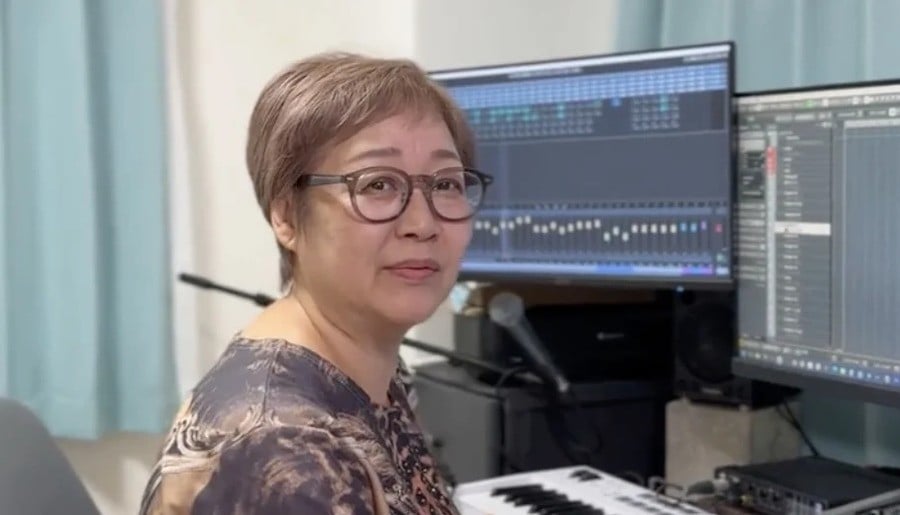
Time Extension: If you’d allow us, we’d start the interview by going back to the very beginning of your music career. How did you originally get interested in the prospect of writing and performing music for a living?
Fujita: So, originally, I was not intending to have a career in music, never mind game music. I was in a design academy or a design college, and they introduced me to a company called SNK. And so when I applied for that company, I had listed music composition as a hobby and SNK had asked me if I was interested in joining the company as a composer rather than as a designer as I had originally intended.
Time Extension: Before joining SNK and working on games like Mad Crasher (1984), how familiar exactly were you with video games and video game music? Were video games a hobby that you were particularly interested in or did you find yourself becoming more interested after you joined SNK?
Fujita: So my father was into games and would often take me to arcades after school before I got a job at SNK. So that was roughly what my exposure was before joining the company.
Time Extension: That’s interesting to hear. Were there any games that come to mind that you remember playing on those trips?
Fujita: I don’t clearly remember the titles but I do remember that one of the games was a car racing game in the arcade. Another one was this game where you have a line on the screen and you have to shoot at it. And I think one of them was a ping-pong game.
Everything I experienced at SNK was all brand new to me. I was doing everything there for the first time and there weren’t really a lot of people, or any people for that matter, who could teach me how to do the job that I was assigned to do at SNK. And so at the time, a lot of my reference material came from Namco games.
Time Extension: Speaking about SNK, what was the experience like working for that company?
Fujita: So at the time, since the game industry was still very new, everything I experienced at SNK was all brand new to me. I was doing everything there for the first time and there weren’t really a lot of people, or any people for that matter, who could teach me how to do the job that I was assigned to do at SNK. And so at the time, a lot of my reference material came from Namco games. I just found myself playing those and learning from them.
Time Extension: Is it true that Keyboard Magazine was also an important resource for you during this period? We’ve read that Ryuichi Sakamoto, one of the founding members of Yellow Magic Orchestra did a column in that about electronic composition. Is it true that was important in teaching you more about electronic music?
Fujita: So, because I wasn’t really familiar with the intricacies of sound, like sound theory, and such. I leaned on a lot of Ryuichi Sakamoto’s methods when it came to like how to deal with sound volume, how to work with synthesizers, and how to work with waveforms as well. Little things like that, I learned by studying Ryuichi Sakamoto.
Time Extension: You were only at SNK for a year at most. We’re wondering – why did you decide to move on from SNK? And is it true that also around the same time that you applied to Nintendo?
Fujita: Actually yeah, when I decided to leave SNK, I did eventually make it over to Capcom, but I also did apply for a job at Nintendo. I sent in a demo tape of the music I had made up until that point. The person at Nintendo’s sound department wanted to bring me on board so that I could work there, but unfortunately, the HR at Nintendo said they weren’t hiring at the time. So I didn’t end up going to Nintendo. I ended up going to Capcom instead.
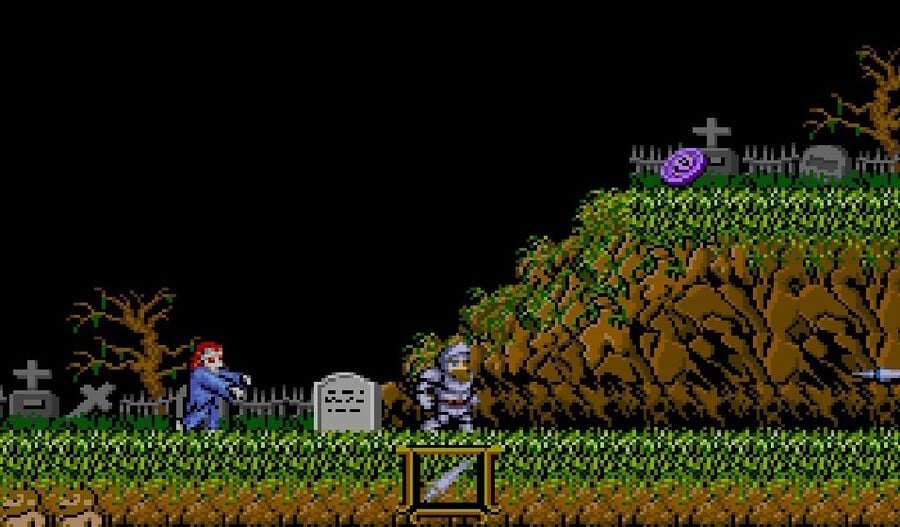
Time Extension: When you joined Capcom, one of the first projects you’re credited on is Ghosts ‘n Goblins, where we believe you did sound effects and the iconic death jingle as well. Is that correct?
Fujita: Exactly, that’s correct.
Time Extension: It would be interesting to hear — do you have any reflection on that game’s development or the legacy it’s kind of taken on since?
Fujita: So this was a bit of an ambitious thing to think about before the game came out, but during development, Ayako Mori-san and I set out to make a game whose music would kind of make it to the history books, and then as luck would have it, that’s apparently what ended up happening.
Time Extension: You’ve collaborated a lot with Tokuro Fujiwara throughout your career. What do you find so special about working with him?
Fujita: So when I joined Capcom, almost all of my projects were under the supervision of — or were directed/produced by — Fujiwara. At the time, he told me to make music that was catchy and that people would not get tired of listening to. Even today, my goal is to make music in that same vein. So that’s how working with him has been a special and unique experience for me.
[Fujiwara] told me to make music that was catchy and that people would not get tired of listening to. Even today, my goal is to make music in that same vein. So that’s how working with him has been a special and unique experience for me.
I ended up passing along that knowledge to people who joined the company after me. So Manami Matsumae, Yoko Shimomura, Takashi Tateishi. I told them to make music largely in the same vein. So that’s how Fujiwara’s impact can still be felt today.
Time Extension: After Ghosts ‘n Goblins, you ended up contributing music to the arcade version of Bionic Commando. We believe it’s called Top Secret in Japan. We’re wondering, was there a specific sound that you were trying to capture with that project? Because it has a very dynamic soundtrack, sort of like a Hollywood film.
Fujita: Bionic Commando was co-composed by myself and Tamayo Kawamoto. We collaborated on the soundtrack by having one person make the first half of the song and another person make the second half of the song. For example, if one song was 32 measures long, I would make the first 16 and the other person would make the last 16, and so on and so forth. I think we were able to combine our strengths to make a very dynamic-sounding album. We were both kind of competing with each other in a sense. We were encouraging each other to outdo the other person, and that’s what led to the soundtrack that you ended up listening to.
Time Extension: We’ve obviously mentioned your arcade work, but you also wrote a lot of memorable scores for the NES and the Nintendo Famicom, including Chip ‘n Dale: Rescue Rangers, Strider, and Mega Man 3 (with Yasuaki “Bun Bun” Fujita). We’re wondering, how did your process for writing music change when you went from writing for the arcade to writing for a less powerful piece of hardware like the Nintendo Famicom?
Fujita: So when I was at SNK, working on games there, I acquired experience composing using PSG audio. And I was able to take that technological know-how and apply that to composing for the NES and the Famicom. So, you know, my motivation was to see how far I could go composing for the NES with that know-how that I acquired, and things turned out the way that I hoped for in terms of the quality of the output.
Time Extension: Do you have a favourite score from your work on the Nintendo Entertainment System/Famicom?
Fujita: That would be Makaijima.
Time Extension: It’d be interesting to know about your 16-bit output, such as the music you did for the Super Famicom with Ukiyotei. For example, do you have any specific memories of working on Skyblazer? Because that game clearly feels like a bit of a departure for you in terms of its musical styling.
Fujita: Skyblazer is set in India, so I was told to make a soundtrack that would reflect that kind of setting. And so, yeah, that’s why it sounds the way it does.
Time Extension: So, in order to accomplish that, did you use any real-life references to compose the soundtrack? Were there any particular albums or artists that you referred to?
Fujita: So I’m not the kind of musician who listens to other albums and then uses them as a reference. I tend to just listen to my gut. So I rely on my own individual image of what something is supposed to sound like and that’s typically how I write.
Time Extension: Another Ukiyotei-developed Super Famicom game we have to mention, of course, is Cooly Skunk, which you did the music for. We believe it’s only just getting a Super Famicom cartridge release this year or next year. Previously it had only actually appeared as a playable demo on the Nintendo Satellaview service, with the game later being repackaged as a PlayStation title on disc. What is your opinion on the game (and your soundtrack) finally getting a physical cartridge release all these decades later?
Fujita: I thought that the game had really great graphics and overall was pretty well made, including the music. So I didn’t actually realize for a long time that the game had never actually come out. So when the revival of Cooly Skunk was crowdfunded, I was approached by the manager of the crowdfunding campaign and I was more than happy to help in terms of offering to cooperate with the project and providing the music again. It’s good to see it coming out finally.
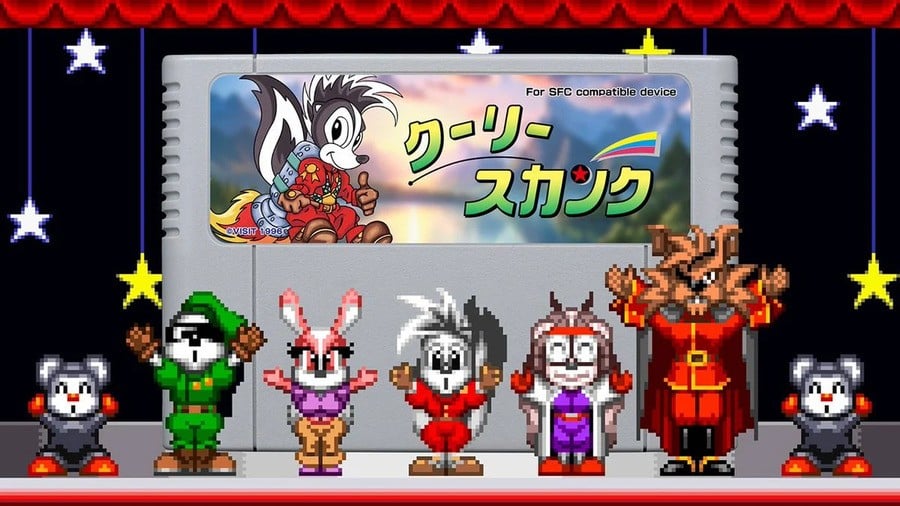
Time Extension: Another project that would be interesting to talk about is Tomba because obviously, Tomba Special Edition was a thing recently. We’re wondering — what was the experience like going back to that soundtrack and remastering it for the modern day?
Fujita: Tomba is a soundtrack that I have a very strong affinity for. I like every track in the game and the PlayStation version used sampled audio, so it’s not reflective entirely of the songs that I composed on the synthesizer. So, when it came to revisiting Tomba for the special edition, I decided to go back to the original source material and base the new soundtrack on that. So it wouldn’t be sampled audio like the original PlayStation game was.
My personal wish was to do more with those arrangements and change the tracks up a lot more than I eventually ended up doing, but I realized that there are people out there who enjoy Tomba and remember Tomba, and I didn’t really want to veer too far away from those people’s memories. So my main priority was to make new arrangements that would obviously be memorable but also induce feelings of nostalgia in people who had played the original version.
Time Extension: Right now, you are represented by the record label Brave Wave Productions. So it would be interesting to hear about the collaborations that you’ve been doing with them. How did you initially come on board at Bravewave and become part of their kind of roster of musicians?
Fujita: I was introduced to Mohammed [Taher], the founder of Brave Wave, by Manami Matsumae. I remember Mohammed being very excited but worried at the same time. He asked me if I would be willing to join the label and I ended up accepting the offer on the spot.
Time Extension: One of the amazing things you did with Brave Wave recently was the Giants album where we believe there are two tracks you’re credited on — one of which is a collaboration with your fellow Mega Man 3 composer Yasuaki “Bun Bun” Fujita — who took over the project while you were pregnant. Do you have any thoughts on that project and that particular song “Full Circle”?
Fujita: So, yeah, that track was a collaboration between myself, Bun Bun, and the son I was pregnant with when had to leave Mega Man 3 halfway through development. Bun Bun who composed the track initially and then sent it over to me, I arranged it, and then it was my son who ended up mixing the track. So it was a little bit poetic that I handed off the original Mega Man 3 to Bun Bun because I was pregnant with my son, and then many years later, the son I was pregnant with at the time was able to contribute to the arrangement of this track. So it’s really meaningful that track is in terms of all of the people involved.
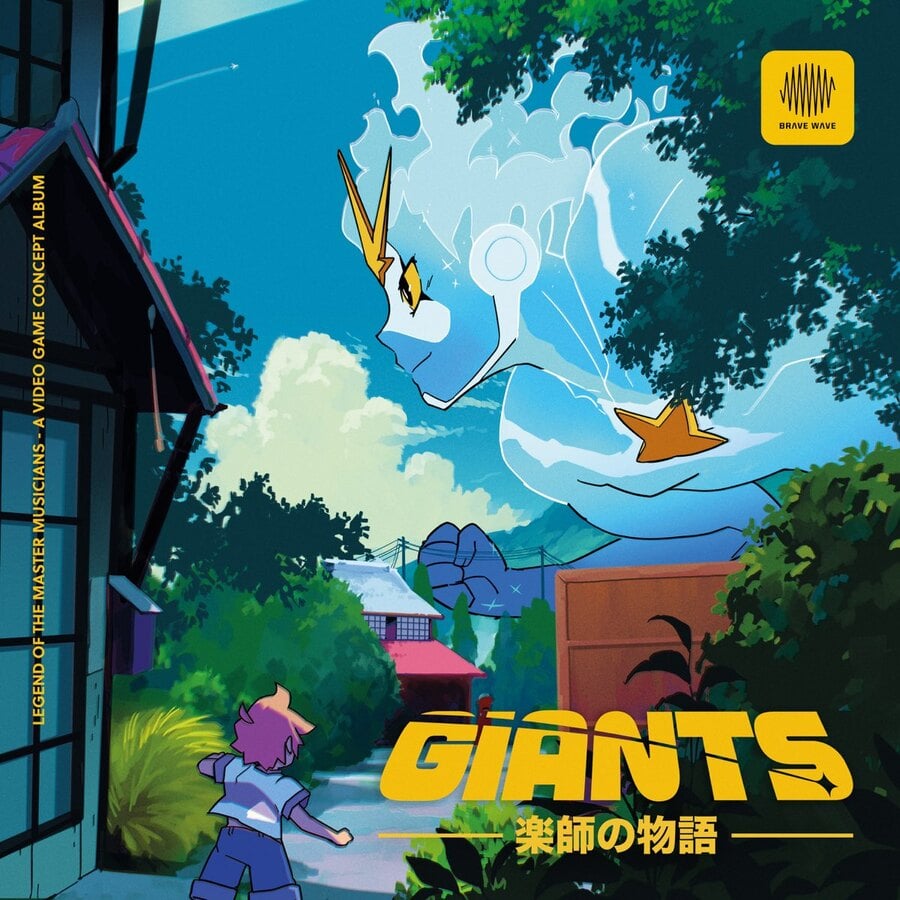
Time Extension: Do you plan on collaborating much with your son in the future? Or have you already been collaborating with him behind the scenes?
Fujita: So, yeah, my son now mixes all of my tracks, but also in addition to that, acts as a producer of sorts for all the other stuff that I’m doing now, including my TikTok account. So he like advises me on the kind of direction I should take for each track and how I could improve things, though I sometimes find his advice annoying (in a nice way).
Time Extension: Is there anything that you can talk about now that you’re working on in terms of your soundtrack work?
Fujita: I’m working on a mobile smartphone game. It’s not announced yet. Other than that, I’m mostly doing OkanP stuff right now.
Time Extension: Do you have a closing message for fans of your music?
Fujita: By doing OkanP activities on TikTok, Instagram, and YouTube, a lot of people comment on my music and some of the messages I’ve received from commenters and listeners are to the effect of, ‘Your music has made me happy again’ or ‘It’s given me more motivation to continue making my own music.’
I’m very happy that my music seems to be motivating and inspiring people to do the things that they want to do. I hope that by continuing to do what I’m doing, more people will continue to be inspired and influenced positively by my music.
Go on.... treat yourself to a new game.


